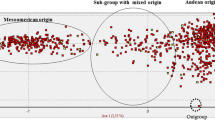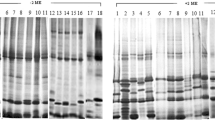Abstract
Phaseolin type, determined by one-dimensional sodium dodecyl sulfate polyacrylamide gel electrophoresis, was used to suggest dissemination routes of common bean (Thaseolus vulgaris) cultivars from their areas of domestication to Europe and Africa. In the Iberian Peninsula, ‘C’ was the most frequent phaseolin type. Only in Chile has a comparably high ‘C’ frequency been observed previously, indicating that many Iberian cultivars may have been introduced from Chile, or that many Chilean cultivars may have come from the Iberian Peninsula. In Europe (outside the Iberian Peninsula), most cultivars exhibited a ‘T’ type. The high frequency of this type may be related to the high frequency of green pod cultivars among European cultivars. Most African cultivars exhibited a ‘T’ or a ‘C’ type and may have been introduced from Brazil, the Iberian Peninsula, or western Europe. ‘T’ or ‘C’ cultivars had larger seeds than ‘S’ cultivars. The phaseolin patterns of cultivars with different seed types and of early French cultivars are discussed.
Similar content being viewed by others
Literature Cited
Ammerman, A. J., and L. L. Cavalli-Sforza. 1984. The Neolithic transition and the genetics of populations in Europe. Princeton Univ. Press, Princeton, NJ.
Berglund-Brücher, O., and H. Brücher. 1976. The South American wild bean (Phaseollis aborigineus Burk.) as ancestor of the common bean. Econ. Bot. 30:257–272.
Bock, H. 1546. Kreuterbuch. A 1577 edition of this work, with the section on common bean unaltered, was reprinted in 1964 by K. Kölb, München, West Germany.
Brown, J. W. S., F. A. Bliss, and T. C. Hall. 1981. Genetic variation in the subunits of globulin-1 storage protein of French bean. Theor. Appl. Genet. 59:83–88.
—, J. R. McFerson, F. A. Bliss, and T. C. Hall. 1982. Genetic divergence among commercial classes ofPhaseolus vulgaris in relation to phaseolin pattern. HortScience 17:752–754.
Cafati, K. C. 1973. Variedades de frijol. Investigatión y progreso agrícola, Instituto Nacional de Investigaciones Agrícolas (INIA), Chile 5:10–11.
Cariot, A. 1865. Haricot. In Botanique elémentaire, descriptive, et usuelle, Vol. 3:187–188. Flore horticole et dictionnaire. Girard et Josserand, Paris.
Dagnelie, P. 1969. Théorie et méthodes statistiques. 2 vol. Duculot, Gembloux, Belgium.
Dioscorides. 1 st Century A.D. The Greek herbal of Dioscorides, illustrated by a Byzantine, A.D. 512, Englished by J. Goodyer A.D. 1655, edited and first printed A.D. 1933 by R.T. Gunther. Facsimile (1968) of the 1934 edition. Hafner, London.
Dodoens, R. 1554. Cruydeboeck, Plantijn, Antwerp. Reprinted in 1971 by the De Forel, Nieuwendijk.
Evans, A. M. 1976. Beans. Pages 168–172in N. W. Simmonds, ed., Evolution of crop plants. Longman, London.
Fuchs, L. 1543. Von Welschen Bonen. Cap. CCLXIXin Neu Kreuterbuch. Michael Isengrin, Basel. Reprinted in 1964 by K. Kölb, München, West Germany.
Gepts, P. 1984. Nutritional and evolutionary implications of phaseolin seed protein variability in common bean (Phaseolus vulgaris L.). Ph.D. Thesis, Univ. Wisconsin-Madison, Madison, WI.
—, and F. A. Bliss. 1986. Phaseolin variability among wild and cultivated common beans from Colombia. Econ. Bot. 40:469–478.
—, K. Kmiecik, P. Pereira, and F. A. Bliss. 1988. Dissemination pathways of the common bean (Phaseolus vulgaris) deduced from phaseolin electrophoretic variability. I. The Americas. Econ. Bot. 42:73–85.
—, T. C. Osborn, K. Rashka, and F. A. Bliss, 1986. Electrophoretic analysis of phaseolin protein variability in wild forms and landraces of the common bean,Phaseolus vulgaris L.: evidence for two centers of domestication. Econ. Bot. 40:451–468.
Gerard, J. 1633. The herbal or general history of plants. Reprinted in 1975 by Adam J. Slip, Joice Norton, and Roger Whitakers, London, Dover, New York.
Gibault, G. 1912. Haricot commun (Phaseolus vulgaris L.). Pages 301–310in Histoire des légumes. Librairie Horticole, Paris.
Gray, A., and J. H. Trumbull. 1883. Review of De Candolle’s origin of cultivated plants; with annotations upon certain American species. Amer. J. Sci. 26:128–138.
Hedrick, U. P. 1931. The vegetables of New York: the beans of New York. New York Agric. Exp. Sta. Rep. 1:1–110.
Heresbach, C. 1570. Rei rusticae libri quatuor. Ioannis Birchmann, Cologne. Reprinted in 1970, in German translation, by Hain, Meisenheim, West Germany.
Leakey, C. L. A. 1970. The improvement of beans (Phaseolus vulgaris) in East Africa. Pages 99–128 in C. L. A. Leakey, ed., Crop improvement in East Africa. Commonwealth Agricultural Bureaux, Farnham Royal, U.K.
Linnaeus, C. 1753. Species plantarum. Reprinted in 1957 by the Ray Society, London.
Ma, Y., and F. A. Bliss. 1978. Seed proteins of common bean. Crop Sci. 18:431–437.
Maréchal, R., J.-M. Mascherpa, and F. Stainier. 1978. Etude taxonomique d’un groupe complexe d’espèces des genres Phaseolus et Vigna (Papilionaceae) sur la base de données morphologiques et polliniques traitées par l’analyse informatique. Boissiera 28:1–273.
Martens, G. von. 1869. Die Gartenbohnen. Ihre Verbreitung, Cultur und Benutzung. 2nd ed. Ulmer, Ravensburg, Germany.
Miller, P. 1754. The gardeners dictionary. Reprinted in 1969 by Cramer, Lehre, West Germany.
Orkin, S. H., and H. H. Kazazian. 1984. The mutation and polymorphism of the human β-globin gene and its surrounding DNA. Ann. Rev. Genet. 18:131–171.
Pagnier, J., J. G. Mears, O. Dunda-Belkhodja, K. E. Schaefer-Rego, C. Beldfjord, R. L. Nagel, and D. Labie. 1984. Evidence for the multicentric origin of the sickle-cell hemoglobin gene in Africa. Proc. Natl. Acad. Sci. U.S.A. 81:1771–1773.
Palmer, J. D., R. A. Jorgensen, and W. F. Thompson. 1985. Chloroplast DNA variation and evolution in Pisum: patterns of change and phylogenetic analysis. Genetics 109:195–213.
Parmentier, P. 1902. Traité élémentaire et pratique de botanique agricole. Octave Doin, Paris.
Simmonds, N. W. 1976. Evolution of crop plants. Longman, London, England.
Sturtevant, E. L. 1919. Phaseolus vulgaris. Common bean, haricot, kidney bean; bush bean. Pole beans. Pages 422-428in U. P. Hedrick, ed., Sturtevant’s notes on edible plants. New York Agric. Exp. Sta. 27th Annual Rep. 2(2).
Tabernaemontanus, J. T. ca. 1590. Von Bonen. Pages 876–879 in Krauterbuch. Königs, Basel, Switzerland.
Theophrastus. ca. 300 b.c. De historia plantarum. Reprinted in 1971. German translation (Naturgeschichte der Gewächse, by K. Sprengel) by Wissenschaftlich Buchgesellschaft, Darmstadt, West Germany.
Tournefort, T. de. 1797. Le haricot,Phaseolus. Pages 374–378in Eléments de botanique, Vol. 2. Bernusset, Lyon, France.
Turner, W. 1538. Libellus de re herbaria. Reprinted in 1965 by the Ray Society, London.
Van Rheenen, H. A. 1979. Diversity of food beans in Kenya. Econ. Bot. 33:448–454.
Westphal, E. 1974.Phaseolus. Pages 129–176in Pulses in Ethiopia, their taxonomy and agricultural significance. Agric. Res. Rep. No. 815. Center for Agricultural Publishing and Documentation (PUDOC), Wageningen, The Netherlands.
Wittmack, L. 1880. [Untitled] Sitzungsber. Bot. Ver. Prov. Brandenburg 21:176–184.
—. 1888a. Die Heimat der Bohnen und der Kürbisse. Ber. Deutsch. Bot. Ges. 6:374–380.
-Wittmack, L.. 1888b. Die Nutzpflanzen der alten Peruaner. éricanistes: p. 325–348.
Zeven, A C. 1979. Collecting genetic resources in highly industrialized Europe, especially the Netherlands. Pages 49–58in Proc. Conf. Broadening Genet. Base of Crops. Center for Agricultural Publishing and Documentation (PUDOC), Wageningen, Netherlands.
Author information
Authors and Affiliations
Rights and permissions
About this article
Cite this article
Gepts, P., Bliss, F.A. Dissemination pathways of common bean (Phaseolus vulgaris, Fabaceae) deduced from phaseolin electrophoretic variability. II. Europe and Africa. Econ Bot 42, 86–104 (1988). https://doi.org/10.1007/BF02859038
Received:
Accepted:
Issue Date:
DOI: https://doi.org/10.1007/BF02859038




